HOME > Exhibitions > Past
- Special Exhibition
National Treasure Irises Screens: A Legacy of Poetic Allusion - April 13, Wednesday- May 15, Sunday, 2016
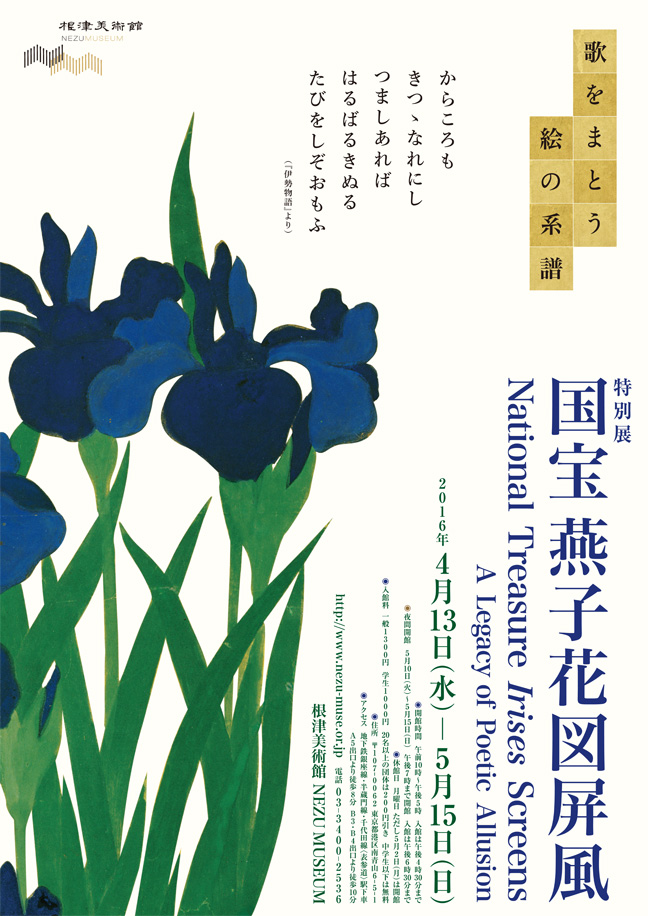

| Closed | Mondays, except 5/2 |
|---|---|
| Hours | 10 am to 5 pm (Open till 7 pm from May 10-15. Entrance closes 30 min. before closing) |
| General admission | Adult 1300 yen, Student 1000 yen |
| Gallery | 1/2 |
The season of the Irises screens has come once again. This time, we hope you will enjoy the masterpiece by Ogata Kōrin (1658–1716) in the context of waka poetry.
The Irises screens are believed to have illustrated a section from the classical poetic narrative, The Tales of Ise. This section of the work relates how the protagonist, who is on his way to the Eastern Provinces, notices the clusters of irises at Yatsuhashi in the province of Mikawa, and is reminded of the wife he has left in the capital (Kyoto). The climax of this scene comes when he composes a waka poem using the five syllables of the word for iris, kakitsubata to start the five lines of the poem. (In pre-modern Japanese, ha and ba were written the same.):
KArakoromo / KItsutsu nare ni shi / TSUma shi areba / HArubaru kinuru / TAbi o shi zo omou
Since I have a wife / familiar to me as the hem / of a well-worn robe, / I think sadly of how far / I have traveled on this journey. (trans. Newhard and Cook)
The symbolism of the imagery of the Irises screens virtually resonates throughout with the sentiment of this poem.
Japanese poetry and painting have long been intimately connected. From uta-e, “poem-pictures,” that express the meanings of poems and meisho-e, “famous place pictures,” depicting renowned locations that were celebrated in poetry, the relationship between poem and painting has unfolded in a diversity of forms, including paintings bearing poetic inscriptions, pictorial subjects adopted from lines of poetry, and groups of works such as genji-e, “Genji pictures,” illustrating poems extracted from narrative tales. This exhibition presents a selection of visual works that display these sorts of connections with waka poetry, providing a vivid backdrop for appreciating the Irises screens.
In addition to objects from the museum’s own collection, the exhibition also features a special loan of a three-volume handscroll of The Tales of Ise (private collection) that was produced in the Muromachi period, offering an ideal opportunity for experiencing the world of The Tales of Ise.
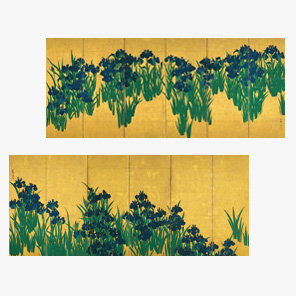

- Irises By Ogata Kōrin
- Japan Edo period, 18th century Nezu Museum
- With its clusters of irises in vibrant full bloom over a solid gold ground, the appeal of this work lies in its design-like composition, which resembles the patterns seen on kosode robes. The iris motif invites the imagination to reflect on the “Journey to the East” section of Episode 9 of The Tales of Ise. It could even be the very scene witnessed by the protagonists of the tale.
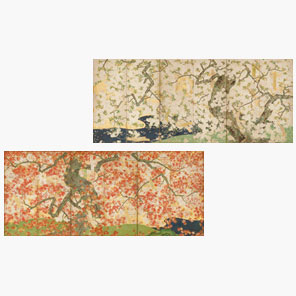
- Cherry Blossoms in Yoshino and Maple Leaves in Tatsuta
- Japan Edo period, 17th century Nezu Museum
- These spectacular screens depict cherry blossoms at the height of their luxuriant bloom and maple leaves brilliant like embroidered brocade. The poem slips tied to the branches of the trees are inscribed with waka poems celebrating the regions of Yoshino and Tatsutagawa, and the cherry blossoms and maples leaves for which they are famous. It is a work that fuses the decorative nature of Japanese art with the tradition of paintings of famous places, or meisho-e.
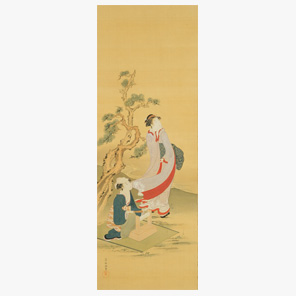
- Beauties Fulling Cloth By Kubo Shunman
- Japan Edo period, 18th-19th centuries Nezu Museum
- This painting of beauties is believed to be based on an old waka poem describing how the loneliness of the wind blowing in the pines was heightened even further by the sound of beating cloth on the fulling block. It is a masterpiece by the cultured and versatile ukiyo-e painter Kubo Shunman (1757–1802).
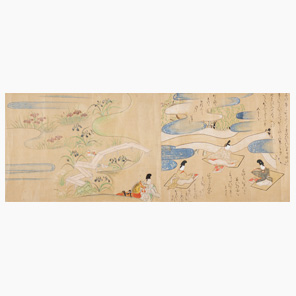
- The Tales of Ise handscroll
- Japan Muromachi period, 16th century Private Collection
- This handscroll is comprised of the text and illustrations of the 125 episodes of The Tales of Ise. Although the pictures reflect a certain naivety, features such as the expressive nature of the unusually large flowering plants give it a rich appeal. Another special feature of this work is that it depicts not the narrative of the tale itself, but rather consists of many scenes illustrating the content of the waka poems that appear in the tale.










